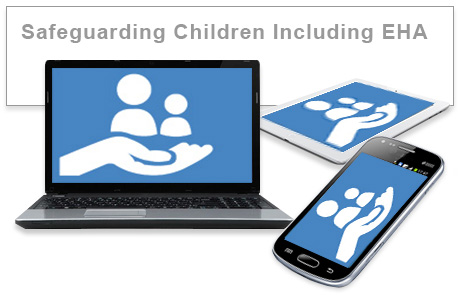safeguarding-children-including-eha-f
Safeguarding Children Including EHA (F): e-learning training course

A comprehensive six-unit module, combining a legislative overview with day to day responsibilities for accurate information sharing, alerting and instigating early intervention. On completion learners will have an improved understanding of their role in relation to child protection.
Modules cover essential information including child abuse, neglect, alerting, disclosure, assessing risk and information sharing; using scenarios and case studies to illustrate the application of learning.
CPD Certificate: 5 hours
Unit Titles and Descriptions
Unit 1 – How to Use the Course
Unit 2 – Basic Principles
Describes the Government’s official definition of Safeguarding Children and provides a clear explanation of the principles of safeguarding. Learners will discover how to apply these principles in both professional and domestic roles.
Unit 3 – What to do
Discusses the decision-making process as applied in this context. Explains how local protocols are informed by key principles and legislation, and concludes with guidance on how to proceed when child abuse is suspected, actual, ongoing or disclosed.
Unit 4 – Introduction to the Early Help Assessment
Presents the key aims and appropriate application of the Early Help Assessment. Illustrates the value of early intervention in limiting the potential for minor concerns to develop into crisis, describes the importance of skilled support for parents and carers at the first point of concern and demonstrates the value of preventative support services.
Unit 5 – Sharing Information
Emphasises the essential role of information sharing in Integrated Working and achieving the key outcomes of Every Child Matters. Real life case studies demonstrate the value of shared information when looking to identify children and young people with additional needs at an early stage. The unit concludes with guidance on balancing the need to share information with the right to privacy for children and families.
Unit 6 – Case Studies
This unit can be used as the basis for staff training sessions, for individual learning and continuing professional development or as a day-to-day reference for staff.
Requires learners to make appropriate safeguarding decisions based on detailed case study information.
Learning Objectives include:
- Describe the principle types of child abuse and identify signs and symptoms
- Identify the underlying factors which increase the likelihood of abuse
- List the principle Acts providing the legal framework for child protection
- Give reasons for the difficulties in obtaining information from children
- Identify the particular vulnerability of children with additional needs
- Define ‘alerting’ and describe the role of the alerter
- Record and report on cases of abuse or concerns about abuse
- Explain the benefits of the Early Help Assessment
- Explain the value of information sharing and where it fits with integrated Working
- Deal appropriately with disclosure by a child
- Advise a child in potential risk situations.
A Safeguarding Adults course is also available.
Copyright Notice | Terms and Conditions | Privacy Statement | Disclaimer |
Copyright © 2006 - 2024 Embrace Learning Ltd.